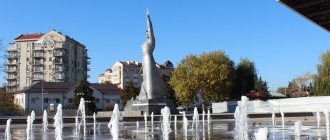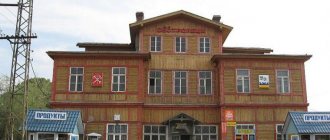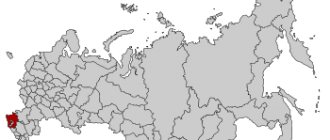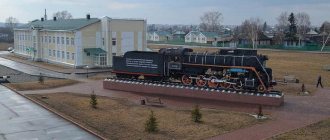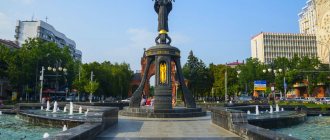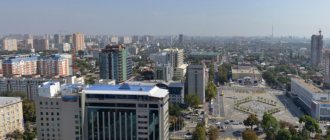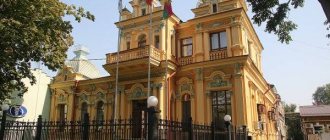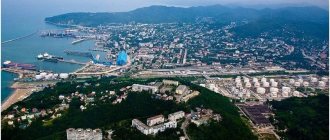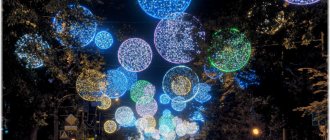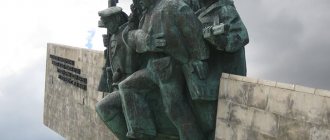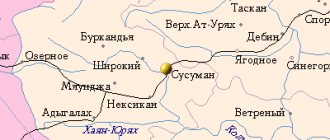- Reports and messages
- Miscellaneous
- Krasnodar city
The capital of Kuban, the city of Krasnodar, is located in the southern part of Russia.
This is a small city with a population of just over 800 thousand people. In 1920 the city received its official name. Initially representing a small military settlement. Under the great leadership of Catherine II, the Cossacks conquered the territory between the Kuban River and the Sea of Azov. And they named it Ekaterinodarm, which in 1860 became the administrative center. Catherine the Great, in turn, decided to thank the Cossacks by allocating them this territory, which later received the name Krasnodar.
Tourists often end up in Krasnodar by accident, driving to the warm Azov Sea, but despite this, the city is still popular. And it deserves special attention from travelers.
The bulk of all the attractions are located near Red Street. At first it looked like a strip of land plowed by oxen, but over the years it was noticeably transformed. On holidays and weekends, the road on the street is blocked, which allows tourists and residents to walk along it without fear.
The city is growing rapidly, combining multi-story residential high-rises, the private sector and outlandish buildings of the modern world. It consists of wide avenues, narrow streets, new and old courtyards.
Another equally famous attraction of the city is the singing fountain, located on the square. More than three hundred statues are part of it. The total height of the fountain is equal to the height of a nine-story building. At night it is a creation of amazing beauty. Bright lights and music attract all citizens and travelers.
The city has many attractions. Among which you can visit the Krasnodar Embankment, the rope park and the bridge of kisses, the Church of Christ and the Holy Trinity Cathedral, the monument to Shurik and his beautiful companion Lida. Chistyakovskaya Grove and Sunny Park, as well as the Moorish House. It is one of the most unusual attractions of the city. It is called a house with a sad love story. When the parents of one Georgian girl disagreed with their daughter’s choice. After all, her choice pointed to an ordinary architect from a poor family, which her parents did not like. For this they took her to Georgia, where the girl died in anguish for her loved one. And the young man, in honor of his strong love, built a beautiful mansion where he planned to spend his life with the Georgian beauty. But he spent it alone until the end of his days.
Krasnodar is a city of love, where dreams come true.
general information
Today Krasnodar is the administrative center of one of the developed Russian regions. In 2016, its population exceeded 850 thousand people. Unofficially, the city is called the southern capital of Russia. In ancient times, this place was the site of a fortification and settlement of the Bosporan kingdom. Thanks to archaeological expeditions carried out here, in the very center of present-day Krasnodar, a fairly large Meotian settlement was discovered, dating back to the third century BC. During the same period, not far from it there was a castle of King Arifarnes. In ancient times, this territory was inhabited by Scythians, Meotians and Sarmatians. In this article we will talk about how the founding of the city of Ekaterinodar took place, which was renamed Krasnodar in 1920. The reader will learn about the prerequisites for the founding of a new settlement and interesting events associated with it.
Climatic conditions
Knowing where Krasnodar is located, you can guess what the climate is like here. After all, in the south of Russia it is significantly warmer than in the central part of the country and in the north. The climatic conditions are ideal for living; the climate is mild continental; intrusions of arctic air are extremely rare. Krasnodar is characterized by sudden changes in weather, which especially concerns air temperature. This is due to the fact that the city is open to the invasion of warm and cold air masses.
During the winter months, temperatures range from 0.6 to 2.1°C above zero. In spring the average is +13 °C, and in summer the thermometer rises to +24 °C. In autumn, the air temperature usually does not drop below + 6.1°C.
Founding of Ekaterinodar
The city has a very interesting history. The founding of Ekaterinodar is directly related to the Black Sea Cossacks. After the annexation of the western territories of Ciscaucasia to the Russian state, they moved to the shores of the Kuban. On the thirtieth of June 1792, Catherine II granted the Black Sea Cossack army a charter, according to which land was transferred free of charge to the Cossacks for their loyalty to the Cossacks in perpetuity. It was located between the Kuban River and the Sea of Azov. From the east, the line of Kuban land ran from the mouth of the Laba to Yeisk. In the spring of 1793, after spending the winter on the Yeisk Spit, a detachment of Cossack settlers, led by Ataman Zakhary Chepega, moved towards the Ust-Labinsk fortification, and then headed down the left bank of the Kuban. Every ten miles, the Cossacks created cordons designed to protect the border of their land from attacks by the highlanders.
Where is the capital of the Krasnodar region?
The city is comfortably located on the right bank of the Kuban River. The distance from Krasnodar to the Black Sea is 120 km, if you follow the highway from the village of Dzhubga; to Azovskoe - 140 km, if you drive along the road from the village of Golubitskaya; to Moscow - 1300 km, if you drive along the M-4 Don.
Krasnodar – which federal district? The region is part of the Southern Federal District and the North Caucasus Federal District. The most remarkable fact of its location is that it is located on the 45th parallel (the so-called line of life), that is, right in the middle between the North Pole and the equator. It is believed that it is at this latitude that optimal climatic conditions for human habitation are formed.
How did the idea to create a city come about?
The founding of Ekaterinodar is entirely the merit of Zakhary Chepega. In June 1793, in the Karasun Kut, the ataman publicly announced his intention to settle on the banks of the Kuban. In July of that year, in his letter addressed to the military judge Golovaty, Chepega reported that he had already found the place where the “military city” would be founded. The founding of Yekaterinodar had the main goal of providing the Black Sea Cossacks with a permanent place of residence. The city was supposed to become a military and administrative center for the Black Sea Cossack army.
Entertainment
There are other places that are recommended to visit in the capital of the Krasnodar Territory. What city doesn’t want to feed its guests plenty, and with the most delicious dishes? So you definitely need to visit at least one popular cafe. For example, “Macho Pizza”, located on the street. Chekistov, 21/1 (Yubileiny microdistrict). The interior of the establishment is decorated in the style of the Wild West. Here you can try not only pizza, but also themed cuisine. The average bill is no more than 300 rubles per person.
Those wishing to taste the culinary delights of Western and European cuisine are recommended to go to the Prague Castle restaurant, which is located on the street. 2nd line, 108 (Slavyanovsky microdistrict). Here relaxing music plays in the background, visitors can watch TV or even play the piano. The average bill is no more than 700 rubles per person.
Active citizens are recommended to go to the Sugar club, located on the street. Krasnoarmeyskaya, 64/2. It is one of the best in the city, because here you can enjoy live sets of the best DJs.
Year of foundation of Ekaterinodar
On August 15, 1793, the highest ranks of the Black Sea Cossack Army decided to found the city. It was supposed to be erected in honor of Catherine II, who gave the land to the Cossacks. The city was called that way - Ekaterinodar, or “gift of Catherine.” On November 19, 1793, Ataman Zakhary Chepega was appointed mayor. It was Danila Volkorez. The founding date of the city of Ekaterinodar falls at the same time. At first, only a quadrangular fortress was founded. Actually, it is from here that the history of the city begins. Almost simultaneously with the construction of fortifications, the Cossacks began to build both kuren and houses in which the garrison was to be housed.
And although construction of the fortress began in the fall of 1793, the official founding date of Ekaterinodar falls on January 1, 1794. It was on this day that the Cossack leadership adopted a document in which the status and name of the new settlement were legally recognized.
Life in Ekaterinodar
In the same year, the city area was demarcated. They began to build houses and huts, which were inhabited not only by the military, but also by civilians - blacksmiths, bakers, tailors, weavers, butchers and even icon painters. In total, approximately six hundred people lived in Ekaterinodar at that time. However, life in the new Cossack capital was not sweet. There were impassable roads and dirt everywhere, and people often suffered from malaria. In addition, the Caucasian war broke out, and everything was uneasy around. In 1802, some even proposed moving the capital to the city of Taman.
Description: area and population
However, the population of Krasnodar continues to grow today. As of January 1, 2022, this figure was 899,541 people (eight years ago approximately 713,400 citizens lived here). But already at the end of September this year it was announced that the population had exceeded the one million mark.
The area of the city is 339.31 km². Population density – 2,651.09 people/km². Citizens of different nationalities and religions live in the city. First of all, these are Russians, Armenians, Circassians and Ukrainians.
Important milestones in the history of the city
In 1795, mass construction of Ekaterinodar began. In 1802 the first Orthodox military cathedral was consecrated, a year later a school for Cossack children was opened, and in 1804 a school was opened on its basis. In 1805, more than 1,700 people were already permanently living in Yekaterinodar. In 1819, a military gymnasium was opened here. Gradually the city developed. In 1860, Ekaterinodar received the status of the center of Kuban. In 1867, the city already had its own coat of arms. Later, a railway was brought to it, which was supposed to connect it with Novorossiysk and Tikhoretsk.
↑ Krasnodar football
Krasnodar, among other things, is also interesting because it has two football clubs: “Krasnodar” and “Kuban”. FC Kuban was founded in 1928 and is one of the oldest football clubs in Russia. FC Kuban was founded together with the Dynamo club under the NKVD of the city of Krasnodar, but the club often changed its affiliation with departments due to the political situation in the Soviet Union. “Kuban” played in the USSR Major League from 1980 to 1982. In Russia, the club played in the Major League, first in 1992, then in 2004, 2007, 2009 and 2011.
Fans of the club are usually called Kuban, but are often called Cossacks, Canaries, Toads and Yellow-Greens according to the official colors of the club). FC Krasnodar is a young club. It was founded only in 2008 on the initiative of Sergei Nikolaevich Galitsky, who is both the creator and owner of the club. Bulls, Citizens, Black Buffaloes or simply black and green - this is how Krasnodar players are informally called.
City development
Ekaterinodar grew at an unprecedented pace. In 1868, a law was passed that served as the beginning of the stage of settler colonization in the history of the city. According to it, nonresidents were allowed to settle in all cities and villages in the Kuban region. Not only its indigenous inhabitants, the Cossacks, could already own the land, so Armenians, Persians and Turks began to come here to engage in trade. Industry also began to develop. The city flourished and grew rich, theaters, entertainment venues, many beautiful mansions appeared in it, and a Kuban newspaper began to be published.
The modern appearance of Krasnodar has retained some features of Ekaterinodar. In the old town, the street layout, buildings and churches have been preserved. Ekaterinodar was a military center. And since the buildings in it were mostly wooden and wicker, it had little resemblance to a city.
After the revolution, the city turned into the center of the Cossack counter-revolution. Therefore, it became the scene of fierce battles from the very beginning of the Civil War. The situation around has changed. In fact, the city of Ekaterinodar has turned into the capital of the entire “White South” of Russia. Units of General Kornilov’s army launched an assault on the city on March 27 (old style). The fighting continued until March 31. On this day the city was taken. This was the First Kuban Campaign, followed by the Second, led by Denikin. This continued until 1920, when Ekaterinodar was conquered by the Red Army. This begins the history of another city - Krasnodar, into which it was renamed.
↑ Sights of Krasnodar
Krasnodar is a city with history, a city that has something to remember and something to tell about. If you wander onto Beregovaya Street in Krasnodar, be sure to find a house on it at number 146/4. There is a unique museum there, created thanks to the efforts of Evgeniy Petrovich Lyutsko, and it is dedicated to the work of Vladimir Semenovich Vysotsky. It’s surprising that there is such a museum in Krasnodar, because Vladimir Semenovich himself has never been to this city. Few people know about this museum, even in Krasnodar itself, even though it is open to the public and completely free. On Vinogradnaya Street you can visit the Cossack Museum, dedicated to the history, everyday life, traditions and customs of the Kuban Cossacks.
You can’t help but smile when passing by the monument to one of the most beloved movie characters of the entire post-Soviet space from Leonid Gaidai’s comedy “Operation Y” - Shurik and Lidochka. Surely, everyone who wanders onto Krasnaya Street in the city of Krasnodar will take with them several wonderful photos of bronze movie characters hugging each other. (Hint: The monument is located next to the Kuban Technical University.) On Theater Square in Krasnodar in the evening you can admire the Singing Fountain, which, of course, is not uncommon in many cities, but is the largest light and musical fountain not only in the South of Russia, but throughout Europe.
Music lovers can visit the Krasnodar Regional Philharmonic at the address: Krasnaya Street, building 55. The Philharmonic was opened in 1939, then during the Nazi occupation it was closed by the Germans. Now there are creative groups, concert ensembles, choirs, as well as the Kuban Young Ballet. Of course, when walking along the same Krasnaya Street, you cannot pass by the Alexander Nevsky Cathedral. This temple, like many others, was destroyed by the Bolsheviks during the Red Terror, but after the collapse of the Soviet Union it was restored thanks to the initiative of the governor of Kuban. The construction of the Cathedral lasted for twenty years, and it is, without a doubt, one of the architectural pearls of the warm southern city.
The Royal Gate or the Alexander Triumphal Arch, restored along with the monument to Empress Catherine II in 2006, is not just one of the most beautiful sights of the city, but also reflects the rich history of the city. This arch had to be restored solely from photographs, since, unfortunately, no drawings of this historical structure have survived. On Gogol Street, near house number 68, you can see an unusual, funny monument. And this is a monument not to someone, but to something - this is the whole “zest”, because at this address there is a monument... to a wallet.
This unusual monument, lying right on the sidewalk of the business center, is a gift from the city authorities, dedicated to the 215th anniversary of Krasnodar. Without a doubt, you need to take at least one look at the Obelisk in honor of the bicentennial of the Cossack army. Actually, this monument appeared in Krasnodar back in the nineteenth century, but was destroyed by the Bolsheviks. It was restored for the three hundredth anniversary of the Kuban Cossack army.
Museum of Postal Communications in Kuban, monument to Catherine the Second, Museum of Bodybuilding "Samson" (the only one in Russia), Literary Museum of Kuban, Museum of Military Equipment "Weapons of Victory", Regional Art Museum named after F.A. Kovalenko, Historical and Archaeological Museum-Reserve named after E.D. Felitsyn, Drama Theater named after Maxim Gorky - all this is not a complete list of attractions of the city of Krasnodar.
Interesting Facts
The ataman of the Black Sea Cossacks, Zakhary Chepega, chose a place to found the future city near the Arkhangelsk redoubt. The latter was founded by Alexander Suvorov himself in 1778. The fortress, which began to be built in the fall of 1793, was a prototype of the Zaporozhye fortress and had the shape of a quadrangle. Ekaterinodar became the center for the Black Sea Cossack army. Residential areas of Ekaterinodar, the center of the Black Sea Cossack army, began to appear on the northern side of the fortress.
In 1820, the great poet A.S. Pushkin passed through the city on his way from Pyatigorsk to Taman. In his travel notes, he wrote that he saw the shores of the Kuban, the watchtowers of the Cossack village, and admired them. He wrote a lot of words about the residents of Ekaterinodar themselves. According to Pushkin, the Cossacks were always on horseback, always ready to fight and were “in eternal precaution...”.
In 1837, another great poet, M. Yu. Lermontov, also stayed in Yekaterinodar. At that time he served as an ensign in the Nizhny Novgorod Dragoon Regiment. In Ekaterinodar he found himself passing through on the way to Taman, and then went to Gelendzhik, to the expeditionary detachment of A. A. Velyaminov, to which he was seconded.
Popular message topics
- Crocus flower
Crocus is a primrose, low-growing perennial plant; maximum height 10 centimeters; has no stem; The leaves of the crocus are very narrow and grow from the very ground. The crocus has only three yellow stamens. - Grasshopper
The grasshopper is an insect that lives on the entire planet except Antarctica. Grasshoppers are predators and eat the eggs and larvae of other insects, sometimes catching adult insects that cannot fly. Some species of grasshoppers may sometimes - Creativity of Mamin-Sibiryak
Dmitry Narkisovich Mamin-Sibiryak was born in the Urals, in the village of Visim, which is now located in the Sverdlovsk region, in 1852. The father of the future writer was a priest. The boy is studying at home
